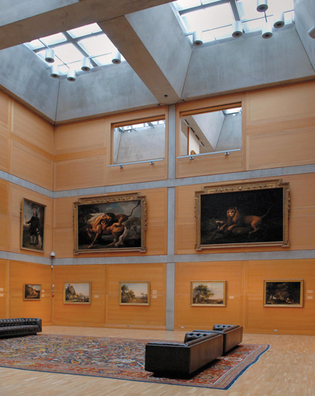 loading
loading
Light & VerityBritish art center will close for a yearAn architectural work of art requires meticulous conservation.  Michael MarslandThe galleries of the Center for British Art will be refreshed during a year-long renovation, and mechanical systems will be updated. View full imageIt’s a familiar story at Yale, or on any college campus: a building that was once glorious is neglected or abused, then, after many years of deferred maintenance, finally restored to its original splendor. That is decidedly not the story of the Yale Center for British Art. Although the 37-year-old building will close for 13 months beginning in January for renovations, the work is all part of the regular upkeep of one of architect Louis Kahn’s most important works. “We consider our building our largest and most complex object,” says director Amy Meyers ’85PhD. Thanks to the endowment provided by the late Paul Mellon ’29, she says, “we’re in the luxurious position that we can attend to our building in a timely fashion.” That means closing the museum’s galleries to the public from January 1, 2015, to early February 2016, so that mechanical systems can be upgraded and galleries and the lecture hall can be refurbished. (The center’s offices will remain open, and the study room and reference library will be accessible by appointment.) During the renovation, a number of works from the center will be on display across the street in the Yale University Art Gallery as part of a joint exhibition called The Critique of Reason: Romantic Art 1760–1860. Works from the center will also be integrated temporarily into the Art Gallery’s European art exhibits. This is the second time the center has closed for a year; the first, in 1998, was for major work on the building’s roof and its skylights. This time, the renovations are being guided by an exhaustively researched conservation plan that establishes 142 policies governing renovations and changes to the building—policies that range from “Respect the roof as a designed element of the building” to “Give due consideration to the relocation of power outlets so that symmetry in placement is respected.” Such plans are becoming increasingly common in the United Kingdom, but Meyers says that YCBA’s—written by British architects Peter Inskip and Stephen Gee in association with YCBA deputy director Constance Clement—is the first ever undertaken in the United States. Completed in 2011, it was published as a hardcover book by YCBA and Yale University Press. The first phase, in 2013, involved the restoration of the center’s study room and the work spaces of its departments of prints and drawings and rare books and manuscripts. In this phase, finishes like woodwork, carpeting, and linens will be refreshed or replaced; a seminar room will be added so teachers can bring their classes in to study pieces from the collection; and the fourth-floor Long Gallery will be restored to Kahn’s original vision of a study gallery. Meanwhile, the curators will take advantage of the 13-month closing to reorganize the works on display. Meyers promises that when the center reopens in February 2016, its entire collection will be “magnificently reinstalled.”
The comment period has expired.
|
|